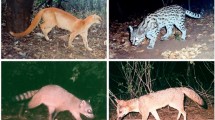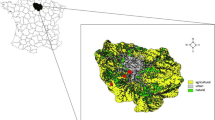Abstract
The European wildcat (Felis silvestris) is a threatened species in Europe. Suitable management of forests has been considered crucial for its conservation in Europe. However, this recommendation may not be general due to the lack of studies that test these hypotheses in the Mediterranean area, where landscapes are very different from those of central-north Europe. In this study, wild-living cat habitat associations were analyzed by means of scat surveys in 78 areas distributed in the four main vegetation types of the Mediterranean area of central Spain, where feral cat populations are probably scarce and restricted. Results show higher occurrences of wild-living cats in landscapes covered by scrub–pastureland mosaics rather than forests. Several applied recommendations are given: (1) to include the scrub–pastureland mosaics as protected habitats for wildcats; (2) to encourage further studies about the importance of this habitat in other areas; (3) to avoid the extensive scrubland removal associated with management practices against fires or infrastructure development; and (4) to promote land management practices that enhance these mosaics, and to use shrub species in the reforestation programmes founded by the European Agricultural Policy.
Similar content being viewed by others
References
Andelt W.F. and Andelt J.H. 1984. Diet bias in scat deposition rate surveys of coyote density. Wildlife Society Bulletin 12: 74–77.
Artois M. 1985. Utilisation de l'espace et du temps chez le renard (Vulpes vulpes) et le chat forestier (Felis silvestris) en Lorraine. Gibier Faune Sauvage 3: 33–57.
Aymerich M. 1982. Etude comparative des régimes alimentaires du lynx pardelle (Lynx pardina) et du chat sauvage (Felis silvestris) au centre de la péninsule Ibérique. Mammalia 46: 515–521.
Aymerich M. 1993. Situación y conservación del gato montés en Europa. Quercus July: 6–11.
Beaumont M., Barratt E.M., Gotelli D., Kitchener A.C., Daniels M.J., Pritchard J.K. et al. 2001. Genetic diversity and introgression in the Scottish wildcat. Molecular Ecology 10: 319–336.
Blas Aritio L. 1964. Estudio de la Distribución de Algunas Alimañas Españolas incluidas en la Clase Mammalia. S.N.P.F.C., Madrid, Spain.
Castells A. and Mayo M. 1993. Guía de los Mamíferos en Libertad de España y Portugal. Ed. Pirámide S.A., Madrid, Spain.
Cavallini P. 1994. Faces count as an index of fox abundance. Acta Theriologica 39: 417–424.
Conroy J.W.H. and French D.D. 1987. The use of spraints to monitor populations of otters (Lutra lutra). Symposia of the Zoological Society of London 58: 247–262.
Corbett L.K. 1978. Current research on wildcats: why have they increased? Scottish Wildlife 14: 17–21.
Corbett L.K. 1979. Feeding ecology and social organization of wildcats (Felis silvestris) and domestic cats (Felis catus) in Scotland, Ph.D. Thesis, University of Aberdeen, Aberdeen, UK, 296 pp.
Council of Europe 1992. Seminar on the biology and conservation of the wildcat (Felis silvestris). Nancy, France, 23-25 September 1992. Council of Europe, Strasbourg, France.
Daniels M.J., Balharry D., Hirst D., Kitchener A.C. and Aspinall R.J. 1998. Morphological and pelage characteristics of wild living cats in Scotland: implications for defining the 'wildcat'. Journal of Zoology London 244: 231–247.
Daniels M.J., Beaumont M.A., Johnson P.J., Balharry D., Macdonald D.W. and Barratt E. 2001. Ecology and genetics of wild-living cats in the north-east of Scotland and the implications for the conservation of the wildcat. Journal of Applied Ecology 38: 146–161.
Dötterer M. and Bernhart F. 1996. The occurrence of wildcats in the southern Swiss Jura Mountains. Acta Theriologica 41: 205–209.
Easterbee N., Hepburn L.V. and Jefferies D.J. 1991. Survey of the status and distribution of the wildcat in Scotland, 1983-1987. Nature Conservancy Council for Scotland, Peterborough, UK.
Fernández E., de Lope F. and de la Cruz C. 1992. Morphologie crânienne du chat sauvage (Felis silvestris) dans le sud de la Peninsule ibérique: importance de l'introgression par le chat domestique (Felis catus). Mammalia 56: 255–264.
Ferreras P., Revilla E. and Delibes M. 1999. Pequeños y medianos carnívoros ibéricos. Biológica 28: 14–37.
Genovesi P. and Boitani L. 1992. Spacing patterns and activity rhythms of a wildcat (Felis silvestris) in Italy. Seminar on the biology and conservation of the wildcat (Felis silvestris), Nancy, France, 23-25 September 1992. Council of Europe, Strasbourg, France, pp. 98–101.
Gil-Sánchez J.M., Valenzuela G. and Sánchez J.F. 1999. Iberian wild cat Felis silvestris tartessia predation on rabbit Oryctolagus cuniculus: functional response and age selection. Acta Theriologica 44: 421–428.
Guggisberg C.A.W. 1975. Wild Cats of the World. David and Charles, Newton Abbott, UK.
Hewson R. 1983. The food of wild cats (Felis silvestris) and red foxes (Vulpes vulpes) in west and north-east Scotland. Journal of Zoology London 200: 283–289.
Hossfeld E., Reif U. and Reith U. 1992. The wildcat in the Taunus mountains: results of preliminary investigations and a draft of a research and protection project. Seminar on the biology and conservation of the wildcat (Felis silvestris), Nancy, France, 23-25 September 1992. Council of Europe, Strasbourg, France, pp. 46–51.
Hubbard A.L., McOrist S., Jones T.W., Boid R., Scott R. and Easterbee N. 1992. Is survival of European wildcats Felis silvestris in Britain threatened by interbreeding with domestic cats? Biological Conservation 61: 203–208.
Langley P.J.W. and Yalden D.W. 1977. The decline of the rarer carnivores in Great Britain during the nineteenth century. Mammal Review 7: 95–116.
Moreno S. and Villafuerte R. 1995. Traditional management of scrubland for the conservation of rabbits and their predators in Doñana National Park, Spain. Biological Conservation 72: 81–85.
Nowell K. and Jackson P. 1996. The wild cats: status survey and conservation action plan. International Union for Nature Conservation/Cat Specialist Group, Gland, Switzerland.
Ozenda P. 1982. Les vegetaux dans le biosphère. Doin Editeurs, Paris.
Palma L., Beja P. and Rodrigues M. 1999. The use of sighting data to analyse Iberian lynx habitat and distribution. Journal of Applied Ecology 36: 812–824.
Parent G.H. 1975. La migration récente, à caractère invasionnel, du chat sauvage, Felis silvestris silvestris Schreber, en Lorraine Belge. Mammalia 39: 251–288.
Ragni B. 1978. Observations on the ecology and behaviour of the wild cat (Felis silvestris Schreber, 1777) in Italy. Carnivore Genetics Newsletters 3: 270–274.
Ragni B. 1981. Gatto selvatico Felis silvestris Schreber, 1777. In: Distribuzione e biología di 22 specie di mamíferi in Italia, Roma. Consiglio Nazionale delle Ricerche, Rome, pp. 105–113.
Rivas-Martínez S., Fernández-González F. and Sánchez-Mata D. 1987. El Sistema Central: de la Sierra de Ayllón a Serra da Estrela. In: Peinado M. and Rivas-Martínez S. (eds), La vegetación de España. Publicaciones Universidad de Alcalá, Madrid, Spain, pp. 419–451.
Roncadell-SECEM 1997. Atlas provisional de los carnívoros de la Comunidad Valenciana. Dirección General del Medio Natural, Generalitat de Valencia, Valencia, Spain.
Sarmento P. 1996. Feeding ecology of the European wildcat Felis silvestris in Portugal. Acta Theriologica 41: 409–414.
Schauenberg P. 1981. Elements d'ecologie du chat forestier d'Europe Felis silvestris Schreber, 1777. Revue d'Écologie (Terre et Vie) 35: 3–36.
Scott R., Easterbee N. and Jefferies D. 1992. A radio-tracking study of wildcats in western Scotland. Seminar on the biology and conservation of the wildcat (Felis silvestris), Nancy, France, 23-25 September 1992. Council of Europe, Strasbourg, France, pp. 94–97.
Stahl P., Artois M. and Aubert M.F.A. 1988. Organisation spatiale et déplacements des chats forestiers adultes (Felis silvestris, Schreber, 1777) en Lorraine. Revue d'Écologie (Terre et Vie) 43: 113–131.
Stahl P. and Artois M. 1991. Status and Conservation of the Wild Cat (Felis silvestris) in Europe and around the Mediterranean Rim. Council of Europe, Strasbourg, France.
Stahl P. and Leger F. 1992. Le chat sauvage (Felis silvestris, Schreber, 1777). In: Artois M. and Maurin H. (eds), Encyclopédie des Carnivores de France. Société Française pour l'Etude et la Protection des Mammifères (S.F.E.P.M.), Bohallard, Puceul, France.
Underwood A.J. 1996. Experiments in Ecology. Cambridge University Press, Cambridge, UK.
Urra F. 1997. Utilización del espacio por el gato montés (Felis silvestris) en Navarra. In: III Jornadas españolas de conservación y estudio de mamíferos, Castelló d'EmpÚries (Girona), 5-7 Diciembre 1997. Sociedad Española para la Conservación y Estudio de los Mamíferos (SECEM), Malaga, Spain, pp. 86.
Virgós E. and Casanovas J.G. 1998. Distribution patterns of the stone marten (Martes foina) in Mediterranean mountains of central Spain. Zeitschrift für Säugetierkunde 63: 193–199.
Wittmer H.U. 2001. Home range size, movements, and habitat utilisation of three male European wildcats (Felis silvestris Schreber, 1777) in Saarland and Rheinland-Pfalz (Germany). Zeitschrift für Säugetierkunde 66: 365–370.
Rights and permissions
About this article
Cite this article
Lozano, J., Virgós, E., Malo, A. et al. Importance of scrub–pastureland mosaics for wild-living cats occurrence in a Mediterranean area: implications for the conservation of the wildcat (Felis silvestris). Biodiversity and Conservation 12, 921–935 (2003). https://doi.org/10.1023/A:1022821708594
Issue Date:
DOI: https://doi.org/10.1023/A:1022821708594




